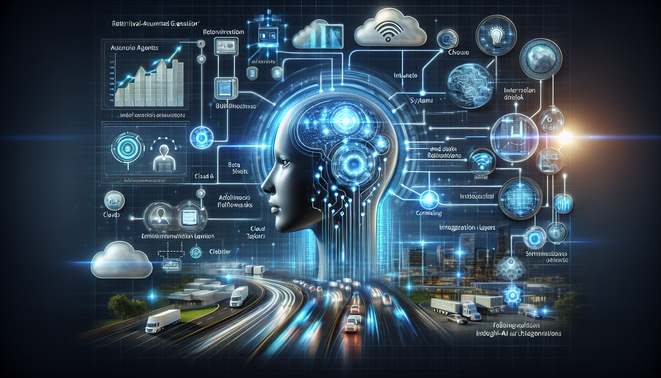Physical Address
304 North Cardinal St.
Dorchester Center, MA 02124
Physical Address
304 North Cardinal St.
Dorchester Center, MA 02124

Understanding Autonomous AI Agents and Retrieval-Augmented Generation (RAG)
Meta Summary: Delve into the world of Autonomous AI Agents and the cutting-edge Retrieval-Augmented Generation (RAG) technique, enhancing AI efficacy in complex tasks. This article explores the RAG architecture, real-world applications, and future trends, providing a roadmap for implementing efficient AI-driven systems.
Introduction to Autonomous AI Agents and RAG
Overview
In the fast-paced realm of technology, Autonomous AI Agents are gaining prominence. These intelligent systems operate independently, efficiently managing tasks without human oversight. A pivotal advancement in their evolution is Retrieval-Augmented Generation (RAG), which melds retrieval-based systems with generative models to boost response precision and context relevance. This synergy empowers AI agents to excel in intricate task management and decision-making, pushing the frontier of autonomous capabilities.
Architecture of RAG in Cloud Workflows
Key Components in Cloud Environments
The architecture of RAG systems in cloud settings consists of several core components:
Data Retrieval Systems: Essential for extracting pertinent data from vast cloud-hosted datasets.
Generative Models: AI frameworks, like neural networks, designed to generate responses using retrieved information.
Integration Layer: Ensures smooth interactions between retrieval and generative components.
Feedback Mechanisms (Decision Loops): Continuously refine AI responses based on new data, enhancing performance.
RAG in the cloud leverages scalability and resilience, integrating cloud services like storage, compute engines, and machine learning tools for optimal efficiency.
Implementing RAG Techniques
Step-by-Step Guide
Data Preparation: Begin by collecting and pre-processing data to maintain high quality and relevance.
Model Selection: Select retrieval and generative models aligned with specific task demands.
Integration: Employ cloud services and APIs for seamless connectivity of retrieval and generative systems, utilizing frameworks like TensorFlow or PyTorch.
Testing and Evaluation: Regular testing is crucial for evaluating performance and refining models.
Deployment: Effective deployment within cloud environments harnesses scalability and efficient resource management.
Note: Ensuring data quality in the preparation phase is fundamental to successful RAG implementation.
Exercises
Develop a Basic RAG Application with available APIs for hands-on practical experience.
Simulate a Decision Loop in Cloud Services to automate simple tasks, deepening your grasp on continuous optimization.
Continuous Decision Loops in Autonomous Agents
Enhancing Efficiency and Automation
Decision Loops are vital in making autonomous agents more efficient. They provide real-time feedback that refines and adapts systems based on user interaction, boosting task automation by:
Boosting Accuracy: Constant adaptation to new data enhances decisions.
Enhancing Efficiency: Automating adjustments reduces manual efforts.
Facilitating Learning: Systems evolve by learning from past interactions, improving over time.
For improved decision-making, employ:
Feedback Analysis: Use feedback trends to drive improvements.
Algorithmic Adjustments: Optimize algorithms to align with user needs.
User Insights: Integrate user feedback for increased relevance.
Exercises
Create a Decision-Making Flowchart for visualizing an agent’s continuous loop.
Introduce a Feedback Loop in a Simple Project to practice adaptive system integration.
Real-World Applications and Use Cases
Transforming Industries
The impact of RAG in various domains is profound. Consider this Case Study: An online retailer deployed RAG for enhanced customer interaction, achieving a 25% sales increase through personalized recommendations. RAG’s ability to tailor suggestions based on user data transformed their customer experience and operational efficiency.
Best Practices in Developing RAG Solutions
Strategies for Success
Adopt Modular Architecture: Facilitate upgrades and maintenance easily.
Incorporate User Feedback: Continuously refine models using user insights.
Monitor Performance: Regular assessment ensures alignment with objectives and changing demands.
For maintainability, prioritize flexible systems designed for scaling according to workload and requirement shifts.
Common Pitfalls and Troubleshooting
Avoiding and Resolving Issues
Recognizing common challenges helps in avoiding them:
Data Quality Oversight: Compromised data quality affects model output; rigorous validation is crucial.
Complex Decision Loops: Keep loops simple and focused to avoid inefficiency.
Scalability Ignorance: Design with scalability in mind to handle demand increases effectively.
Troubleshoot by:
Identifying Bottlenecks: Regularly evaluate and optimize system performance.
Iterative Testing: Validate reliability through continuous testing and iteration.
Scalability Assessments: Ensure systems remain stable under load by conducting stress tests.
Future Trends and Developments in RAG
Looking Forward
The trajectory of RAG technology is promising, with trends such as:
Enhanced Training Techniques: Refining model accuracy and efficiency.
IoT Integration: Broader RAG-IoT fusion will enable smarter systems.
Heightened Personalization: More user-centric developments will cater to unique needs.
Cloud providers will need to expand AI service offerings, driven by growing RAG demand.
Visual Aid Suggestions
Flowchart of RAG Workflow in Cloud: Highlighting data retrieval and response processes.
RAG and Cloud Services Architecture Diagram: Showcasing component interplay.
Key Takeaways
Autonomous AI Agents: Enhance operational efficacy through self-governing AI technologies.
RAG Technology: Merges retrieval systems and generative models for superior AI interaction accuracy.
Decision Loops in Automation: Vital for continuously adapting and refining processes.
Practical Applications: Elevate business value through improved customer experience and efficiency.
Best Practices: Emphasize modularity, user feedback, and performance monitoring for project success.
Glossary
Autonomous AI Agents: Standalone AI systems executing tasks autonomously.
Retrieval-Augmented Generation (RAG): Technique that integrates retrieval systems and generative models for enhanced responses.
Decision Loops: Adaptive feedback systems optimizing tasks based on incoming data.
Knowledge Check
Identify RAG’s Core Components.
Retrieval Systems, Generative Models, Integration Layer, Feedback Mechanisms
How Does RAG Enhance Task Automation?
It improves response accuracy, streamlines efficiency, and reduces manual intervention, leading to precise decisions.
Explain the Importance of the Decision Loop.
It enables real-time feedback, allowing systems to adapt and optimize continuously.
Further Reading
Introduction to Retrieval-Augmented Generation (RAG) – Google Research
Introduction to Retrieval-Augmented Generation – Towards Data Science
Building Intelligent Applications with AI and Machine Learning – Google Cloud Blog
Enhance your understanding of Autonomous AI Agents and RAG by diving into the detailed exploration provided here, empowering innovation and efficiency through AI technologies.